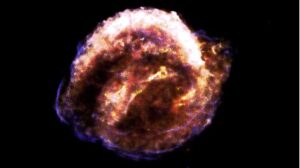The Truth About the New Supernova: It Exploded 20 Million Years Ago

With the appearance close to the Big Dipper of Supernova 2023ixf, backyard telescopes are being pointed to the northern sky after dark to glimpse the violent death of a massive star.
We’re just seeing it now, but it actually happened 20 million years ago. That’s how long the light from the supernova has taken to reach us from the Pinwheel Galaxy where SN 2023ixf resides. Or, rather, did reside. It’s been gone a very, very long time.
A supernova is rare to see and observations of them are fleeting. So much so that every time anyone mentions Betelgeuse—the famous red giant star in Orion in our own galaxy that in 2019 began acting strangely—there’s only one question people want to know the answer to.
When will Betelgeuse explode as a supernova? The answer is rather disappointing: within about 100,000 years.
However, despite its rarity as a cosmic event in real-time, the supernova stage is inevitable for giant stars. It’s also thought to be a key reason why life exists on Earth.
Supernovae Defined
A supernova explosion is the final and sensational self-destruction of a massive supergiant star that can outshine galaxies. They can briefly have the power of up to 100 billion stars.
Some classes of stars are destined to go supernova. Other will not ever go supernova.
Exploding Stars
There are two types of star that go supernova. SN 2023ixf is the first kind—a high mass star whose core collapses. For that to happen to a star, it must be about eight times larger than our sun. As the star exhausts its hydrogen and helium fuel in the core it begins to fuse heavier elements like oxygen and carbon, thus increasing in density as its forms an iron core within layers of gas.
As it reaches a mass it can’t support, a repulsive force triggers an explosive release of energy, pushing the star’s layers into space. That’s a Type II supernovae. That’s SN 2023ixf. All that’s left behind is the collapsed core of the massive supergiant star—a neutron star. That’s what will happen now to SN 2023ixf.
Two Of A Kind
Another kind of supernova, a Type Ia, is by two white dwarf stars—the super-dense cores of dying stars—that orbit each other. In these binary star systems, the stars are thought to get so close that hydrogen is sometimes deposited onto one of the star’s surface by the other until it ignites to causes a nova explosion. They’re hard to detect, so for now theoretical, but the gravitational waves these explosions emit will be detectable by NASA’s upcoming Laser Interferometer Space Antenna (LISA) mission. That will be a groundbreaking mission, though it’s not scheduled to launch until 2037.
Near-Earth Supernovae
At about 20 million light-years from Earth, we’re in absolutely no danger from SN 2023ixf. It’s reckoned that the “kill zone” around a supernova is about 50 light-years. Within that, any planets might be subject to gamma rays that destroy the ozone layer, with ultraviolet radiation from the sun then extinguishing life.
The closest star to the solar system likely to go supernova in the future is indeed Betelgeuse, but it’s at least 550 light-years distant. So we’re currently safe—though there is evidence that Earth was hit by the effects of supernovae about 1.7 to 3.2 million years ago, and also 6.5 to 8.7 million years ago.

Bringers of life
On a cosmic scale, supernovae are much more than just an immediate threat to life. According to NASA, supernovae explosions heat the interstellar medium—the empty space between stars—and spread heavy elements throughout a galaxy. In fact, a lot of heavy elements necessary for life are created by the nuclear reactions inside stars, which are then spewed into the cosmos during a supernova explosion.
The biggest explosions that ever take place in space, the demise of a massive star is both destructive and creative, and the reason our universe is how it is. So don’t feel bad for the star that became SN 2023ixf. Its demise was written in the stars.
Betelgeuse Supernova 2023: Could the star blow up?
Betelgeuse might be the next star in the Milky Way galaxy to go supernova
The red star of Betelgeuse is one of the brightest in our sky.
The supergiant in the constellation of Orion started to noticeably dim in October 2019.
Its brightness returned to its normal range in April 2023. However, across May and June 2023, its brightness increased by almost 50 per cent, which means it can be classed as a variable star.
Betelgeuse’s recent behavior has led scientists to conclude that the star might have entered its final life stage and might go supernova in the near future.
But what is a supernova, why does a star’s brightness change, and why do scientists think the star might explode?
Here is everything we know.
What causes a star’s brightness to change?
While Betelgeuse has shown that its brightness varies in its 400-day cycle, its recent brightness changes have been abnormal.
Astronomers believe that the star was initially dimmed because of a huge ejection of matter, which caused a dust cloud around it, making the supergiant more difficult to spot.
Why do scientists think Betelgeuse may explode?
A star’s life is spent converting hydrogen into helium as its fuel, a process that prevents it from collapsing under its own weight.
However, when a star runs out of hydrogen, the helium starts to burn into carbon, causing the star to swell. When all of the fuel is burned, the star is no longer able to carry its own weight and collapses into a solid neutron star.
A recent paper by Japan’s Tohoku University has concluded that Betelgeuse might be at the final stage of its life, which is the carbon-burning stage.
The leader of the study, Hideyuki Saio, believes that “the core will collapse a few tens of years after the carbon exhaustion”.
However, a group of researchers from Hungary’s Konkoly Observatory have shared that they believe the star is in the earlier helium-burning stage of its lifecycle.
Either way, it seems likely that Betelgeuse will be the Milky Way galaxy’s next supernova but this wouldn’t happen anytime soon. It could even be another 100,000 years before Betelgeuse’s light is finally extinguished.

No responses yet